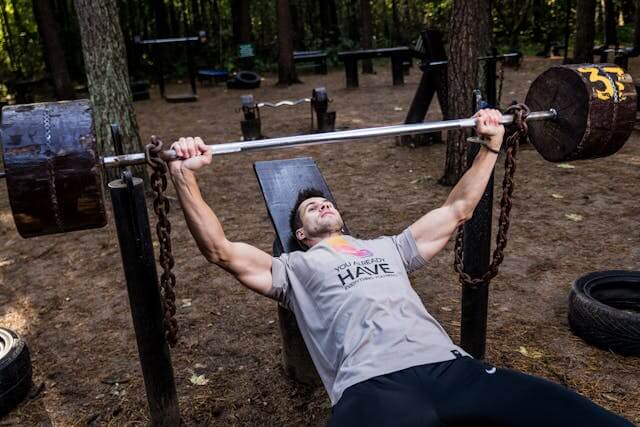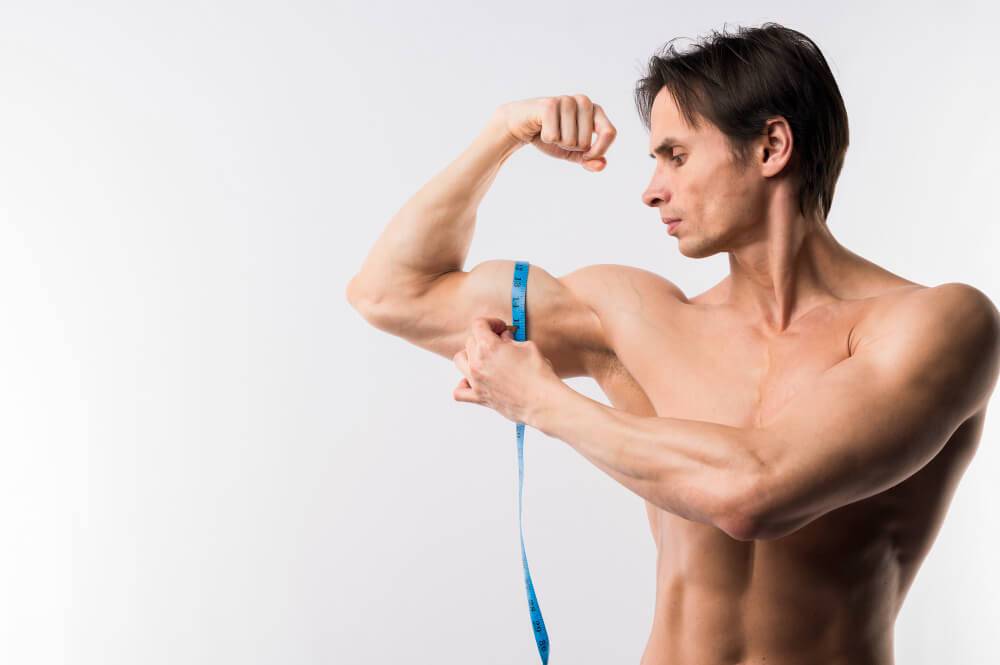When it comes to developing a powerful and well-defined chest, compound exercises are your best bet. These movements engage multiple muscle groups, allowing you to lift heavier weights and stimulate more muscle fibers.
In this blog post, we’ll dive into the top 8 compound exercises for chest development, their benefits, and how you can incorporate them into your workout routine to maximize your gains.
Science Behind Chest Compound Exercises
Compound exercises, also known as multi-joint movements, target several muscle groups simultaneously. For chest workouts, this typically means engaging not just the pectoral muscles, but also the shoulders, triceps, and even parts of the back.

This synergistic approach leads to greater overall muscle activation and strength development. Moreover, compound exercises elicit a hormone response that promotes muscle growth and fat loss.
Benefits of Compound Chest Exercises:
- Increased Muscle Activation: Engaging multiple muscle groups leads to more comprehensive muscle stimulation.
- Efficiency: With compound exercises, you can train more muscles in less time, making your workouts more efficient.
- Functional Strength: These exercises mimic real-life movements, improving overall functional strength and athletic performance.
- Hormonal Response: Heavy compound lifts can trigger a greater release of growth hormone and testosterone, aiding in muscle growth and recovery.
Note: In this article, I have told about best 8 compound exercises for chest. If you want to know about isolation exercises, single joint exercises that are beginner friendly, click here and here.
8 Best Compound Exercises for Chest :
If you’re serious about building a stronger, more defined chest, incorporating compound exercises into your workout routine is essential. Compound exercises are efficient, engaging multiple muscle groups at once, which not only helps you lift heavier weights but also maximizes muscle activation and growth.
Whether you’re a seasoned lifter or just starting, mastering these exercises can significantly improve your chest development and overall upper body strength. Keep reading to discover the top compound exercises that will transform your chest workouts and help you achieve your fitness goals faster. Her is a list of 8 best compound exercises for chest:
Bench Press
The bench press is a foundational compound exercise that primarily targets the pectoral muscles, along with the triceps and shoulders.
The bench press is renowned for building upper body strength and mass, making it a staple in most strength training programs. Proper form and technique are crucial to maximize effectiveness and prevent injury.
How to Perform:
- Setup: Lie flat on a bench with your feet firmly planted on the ground. Grip the barbell with hands slightly wider than shoulder-width apart.
- Lift-Off: With assistance if needed, lift the barbell off the rack and bring it above your chest with arms fully extended.
- Descent: Lower the barbell slowly and under control to your mid-chest, keeping your elbows at a 45-degree angle from your body.
- Press: Push the barbell back up to the starting position, fully extending your arms and squeezing your chest at the top.
- Breathing: Inhale as you lower the barbell, and exhale as you press it back up.
Mistakes to Avoid:
- Arching Your Back Excessively: While a slight arch is natural, over-arching can lead to lower back strain and reduces the effectiveness of the exercise.
- Flared Elbows: Keeping your elbows too wide can place unnecessary stress on your shoulder joints and increase the risk of injury.
- Bouncing the Bar: Allowing the bar to bounce off your chest uses momentum rather than muscle strength, which reduces the effectiveness of the lift and can be dangerous.
- Neglecting Warm-Up Sets: Skipping warm-up sets can increase the risk of injury and reduce your performance during the main sets. Always start with lighter weights to prepare your muscles.
Benefits:
- Targets the entire pectoral muscle.
- Enhances upper body strength.
- Improves muscle coordination and stability.
Push-Ups
Push-ups are a classic compound exercise that targets the chest, shoulders, and triceps while also engaging the core and lower body muscles for stabilization.
This bodyweight exercise is incredibly versatile, requiring no equipment and can be performed anywhere, making it a convenient option for building upper body strength and endurance.
How to Perform:
- Setup: Start in a high plank position with your hands slightly wider than shoulder-width apart, your feet together, and your body forming a straight line from head to heels.
- Descent: Lower your body by bending your elbows until your chest nearly touches the ground, keeping your body straight and your elbows at a 45-degree angle.
- Press: Push your body back up to the starting position by straightening your arms, ensuring your core remains tight and your back flat.
- Breathing: Inhale as you lower your body, and exhale as you push back up.
Mistakes to Avoid:
- Sagging Hips: Ensure your hips do not drop, as this can strain your lower back. Keep your core engaged to maintain a straight line.
- Flared Elbows: Avoid flaring your elbows out to the sides, as this puts undue stress on your shoulders.
- Partial Range of Motion: Lower your chest fully to the ground to ensure complete muscle engagement.
- Head Dropping: Keep your head in a neutral position, looking slightly ahead of you rather than down, to prevent neck strain.
Benefits:
- Can be performed anywhere, no equipment needed.
- Builds endurance and muscle tone.
- Engages core and stabilizer muscles.
Dips
Dips are an effective compound exercise that primarily targets the chest, triceps, and shoulders. This exercise involves lowering and raising your body using parallel bars or a dip station.
How to Perform:
- Setup: Position yourself at parallel bars, gripping each bar firmly with your palms facing inward. Lift your body off the ground, supporting your weight with your arms fully extended and legs crossed at the ankles.
- Descent: Lower your body by bending your elbows, allowing your torso to tilt forward slightly. Descend until your upper arms are parallel to the ground, keeping your movement controlled.
- Press: Push your body back up to the starting position by straightening your arms, ensuring that you maintain a slight forward lean to target the chest muscles effectively.
- Breathing: Inhale as you lower your body and exhale as you press back up.
Mistakes to Avoid:
- Excessive Forward Lean: While a slight forward lean is necessary, over-leaning can strain your shoulders and reduce the effectiveness of the exercise.
- Flared Elbows: Avoid allowing your elbows to flare out excessively during the movement, as this can place undue stress on your shoulder joints.
- Inadequate Range of Motion: Ensure you lower your body until your upper arms are at least parallel to the ground for full muscle engagement.
- Swinging Body: Keep your body stabilized throughout the movement to avoid using momentum, which reduces muscle activation and increases injury risk.
Benefits:
- Great for lower chest development.
- Engages triceps and shoulders.
- Can be weighted for added resistance.
See Also: 9 Best Back Exercises Using Barbell (With Sample Workout Plan)
Incline Bench Press
The incline bench press is a variation of the traditional bench press that targets the upper portion of the pectoral muscles.
By setting the bench at an incline, typically between 15 to 30 degrees, this exercise shifts the emphasis to the clavicular head of the pectoralis major while still engaging the shoulders and triceps. It is a powerful movement for developing the upper chest, adding variety and balance to any strength training program.
How to Perform:
- Setup: Adjust the bench to a 30-45 degree incline. Lie back with your feet flat on the ground and your back firmly against the bench.
- Grip: Grasp the barbell with a grip slightly wider than shoulder-width apart.
- Lift-Off: With assistance if needed, lift the barbell off the rack and position it directly above your upper chest with arms fully extended.
- Descent: Lower the barbell slowly toward the upper part of your chest, keeping your elbows at a 45-degree angle.
- Press: Push the barbell back up to the starting position, fully extending your arms while squeezing your chest at the top.
- Breathing: Inhale as you lower the barbell and exhale as you press it back up.
Mistakes to Avoid:
- Too Steep of an Incline: Setting the bench at too high of an incline shifts the focus from the chest to the shoulders, reducing chest engagement.
- Flared Elbows: Keep your elbows at a natural angle to avoid straining your shoulders.
- Partial Range of Motion: Ensure the barbell comes down to the upper chest to get full muscle activation.
- Arching the Back: Keep your back flat against the bench to maintain proper form and prevent injury.
Benefits:
- Focuses on the upper pectoral muscles.
- Helps create a balanced chest appearance.
- Improves shoulder strength.
Chest Dips
Chest dips are a powerful bodyweight exercise that primarily targets the lower portion of the pectoral muscles while also engaging the triceps and shoulders.
By performing dips with a slight forward lean, the emphasis shifts more towards the chest, making it an excellent exercise for overall chest development. Chest dips can be further intensified by adding weight through a dip belt or holding a dumbbell between the legs.
How to Perform:
- Setup: Locate a set of parallel bars and grip them firmly with your palms facing inward. Lift your body off the ground, supporting your weight with arms fully extended and legs crossed at the ankles.
- Descent: Lower your body by bending your elbows and allowing your torso to lean forward slightly. Descend until your upper arms are parallel to the ground. Control your movement throughout the descent.
- Press: Push your body back up to the starting position by straightening your arms. Maintain a slight forward lean to effectively target the chest muscles.
- Breathing: Inhale as you lower your body and exhale as you press back up.
Mistakes to Avoid:
- Excessive Forward Lean: While a slight forward lean is beneficial, over-leaning can place unnecessary strain on your shoulder joints and reduce the effectiveness of the exercise.
- Flared Elbows: Keep your elbows from flaring out excessively during the movement to prevent undue stress on your shoulder joints.
- Inadequate Range of Motion: Lower your body until your upper arms are at least parallel to the ground to ensure full muscle engagement.
- Swinging Body: Stabilize your body throughout the movement to avoid using momentum, which can reduce muscle activation and increase the risk of injury.
Benefits:
- Excellent for chest and tricep development.
- Engages the shoulders and core.
- Can be made more challenging with added weight.
Decline Bench Press
The decline bench press is an effective variation of the traditional bench press that focuses on the lower portion of the pectoral muscles.
By setting the bench to a decline angle, usually around 15 to 30 degrees, the exercise shifts the emphasis to the lower chest while still engaging the triceps and shoulders. This movement is ideal for achieving a well-rounded chest appearance and adding variety to your chest workout routine.
How to Perform:
- Setup: Adjust the bench to a decline position, typically between 15-30 degrees. Lie down with your legs securely hooked under the foot pads to stabilize your position.
- Grip: Grasp the barbell with a grip slightly wider than shoulder-width apart, ensuring balanced weight distribution.
- Lift-Off: With assistance if needed, lift the barbell off the rack and position it directly above your lower chest with arms fully extended.
- Descent: Lower the barbell slowly toward your lower chest, keeping your elbows at a 45-degree angle to your body.
- Press: Push the barbell back up to the starting position, fully extending your arms while squeezing your chest muscles at the top of the movement.
- Breathing: Inhale as you lower the barbell and exhale as you press it back up.
Mistakes to Avoid:
- Improper Bench Angle: Setting the bench at too steep or too shallow of a decline can misplace focus away from the lower chest muscles.
- Flared Elbows: Avoid flaring your elbows out too much to prevent unnecessary stress on your shoulder joints.
- Partial Range of Motion: Ensure the barbell reaches close to your lower chest to achieve full muscle activation.
- Arching the Back Excessively: Keep your back engaged with the bench, using your legs to stabilize yourself and maintain proper form.
- Uneven Grip: Make sure your hands are evenly spaced on the barbell to avoid imbalances and reduce the risk of injury.
Benefits:
- Targets the lower part of the chest.
- Engages stabilizer muscles.
- Useful for complete chest development.
See Also: 10 Must-Try Back Cable Workouts for Ultimate Strength and Definition
Close-Grip Bench Press
The close-grip bench press is an effective exercise that primarily targets the triceps while also engaging the chest and shoulders.
By using a narrower grip than the traditional bench press, this movement puts more emphasis on the triceps, making it an excellent choice for developing arm strength. It’s also beneficial for improving overall pressing power and can be integrated into a balanced workout routine for comprehensive upper body strength.
How to Perform:
- Setup: Lie on a flat bench, ensuring your feet are firmly planted on the ground. Position yourself so your eyes are directly under the barbell.
- Grip: Grasp the barbell with a narrow grip, approximately shoulder-width apart, ensuring your thumbs encircle the bar for safety.
- Lift-Off: With assistance if needed, lift the barbell off the rack and position it directly above your mid-chest, with your arms fully extended.
- Descent: Lower the barbell slowly to your chest by bending your elbows, keeping them close to your body to maximize tricep engagement.
- Press: Push the barbell back up to the starting position by fully extending your arms, engaging your triceps throughout the movement.
- Breathing: Inhale as you lower the barbell and exhale as you press it back up.
Mistakes to Avoid:
- Wide Grip: Using a grip that is too wide reduces tricep engagement and shifts focus away from the primary muscles targeted.
- Elbows Flaring Out: Keep your elbows tucked close to your body to prevent placing undue stress on your shoulder joints.
- Partial Range of Motion: Lower the barbell all the way to your chest to ensure full muscle activation and optimal results.
- Uneven Grip: Ensure your hands are evenly spaced on the barbell to avoid imbalances and reduce the risk of injury.
- Bouncing the Barbell: Avoid bouncing the barbell off your chest to maintain control and minimize the risk of injury.
Benefits:
- Focuses on triceps while still engaging the chest.
- Enhances upper body strength.
- Improves pressing power.
Landmine Press
The landmine press is a versatile and functional exercise that targets the shoulders, upper chest, and triceps.
It can be performed standing, kneeling, or seated, providing flexibility to suit different fitness levels and goals. The landmine press is particularly beneficial for those seeking to improve shoulder stability and strength while minimizing strain on the joints.
How to Perform:
- Setup: Secure one end of a barbell in a landmine attachment or firmly in a corner. Stand facing the barbell with feet shoulder-width apart. Grasp the free end of the barbell with both hands close together, holding it at chest level.
- Stance: Slightly bend your knees and engage your core to provide a stable base for the lift.
- Press: Press the barbell upward and forward in a diagonal path until your arms are fully extended. Keep your stance steady and avoid leaning back excessively.
- Lowering: Slowly lower the barbell back to the starting position at chest level, maintaining control throughout the movement.
- Breathing: Inhale before pressing the barbell and exhale as you press it upward.
Mistakes to Avoid:
- Leaning Back: Avoid leaning back too much, as this can strain your lower back. Engage your core to maintain a neutral spine.
- Flared Elbows: Keep your elbows from flaring out excessively during the press to focus the effort on your shoulders and chest.
- Using Momentum: Ensure you use controlled movements rather than relying on momentum to lift the barbell, which can reduce the exercise’s effectiveness and increase injury risk.
- Improper Bar Path: Press the barbell in a diagonal path rather than straight up to effectively target your shoulders.
- Uneven Feet Position: Ensure your feet are evenly spaced to stabilize your body and maintain balance.
Benefits:
- Enhances shoulder and upper chest strength.
- Engages the core for stability.
- Versatile and can be performed in various stances.
How to Maintain Proper Form
Using proper form is crucial when performing compound exercises to prevent injuries and maximize results. Here are some general tips:
- Warm-Up: Always start your workout with a warm-up to prepare your muscles and joints.
- Control: Perform each movement with control, avoiding jerky or rushed motions.
- Alignment: Keep your body aligned to ensure even muscle engagement and reduce strain.
- Breathing: Inhale during the eccentric (lowering) phase and exhale during the concentric (lifting) phase.
- Listen to Your Body: If you feel pain (not to be confused with the discomfort of exertion), stop and reassess your form or weights.
Workout Plan

This workout plan is designed to build comprehensive upper body strength by incorporating a variety of compound exercises that target multiple muscle groups simultaneously.
Each exercise is broken down with clear steps on how to perform them correctly and common mistakes to avoid, ensuring you maximize the benefits while minimizing the risk of injury.
Whether you’re a beginner or looking to advance your lifting capabilities, this plan provides flexible yet effective routines to enhance your overall pressing power and upper body development.
Beginners:
- Bench Press: 3 sets of 8-10 reps
- Push-Ups: 3 sets of 10-12 reps
- Dips: 3 sets of 8-10 reps
- Incline Bench Press: 3 sets of 8-10 reps
Intermediates:
- Bench Press: 4 sets of 6-8 reps
- Chest Dips: 4 sets of 8-10 reps
- Incline Bench Press: 4 sets of 6-8 reps
- Decline Bench Press: 3 sets of 8-10 reps
Advanced:
- Bench Press: 5 sets of 4-6 reps
- Weighted Dips: 4 sets of 6-8 reps
- Incline Bench Press: 5 sets of 4-6 reps
- Close-Grip Bench Press: 4 sets of 6-8 reps
- Landmine Press: 3 sets of 10-12 reps
Tips for Progression and Overcoming Plateaus
- Increase Weight: Gradually increase the weight you lift to continue challenging your muscles.
- Change Variations: Switch up the variations of the exercises to target different muscle fibers.
- Adjust Reps and Sets: Vary the number of repetitions and sets to keep your muscles guessing.
- Incorporate Supersets: Pair exercises together to increase intensity and muscle engagement.
- Rest and Recovery: Ensure you’re getting adequate rest between workouts to allow muscles to recover and grow.
Conclusion
Compound exercises are invaluable for developing a strong, well-defined chest. Incorporating the top 8 compound chest exercises into your routine will not only enhance your chest development but also improve overall upper body strength and muscular coordination. You can find more amazing articles on our Blog page.
Remember, consistency and proper form are key. Happy lifting!









